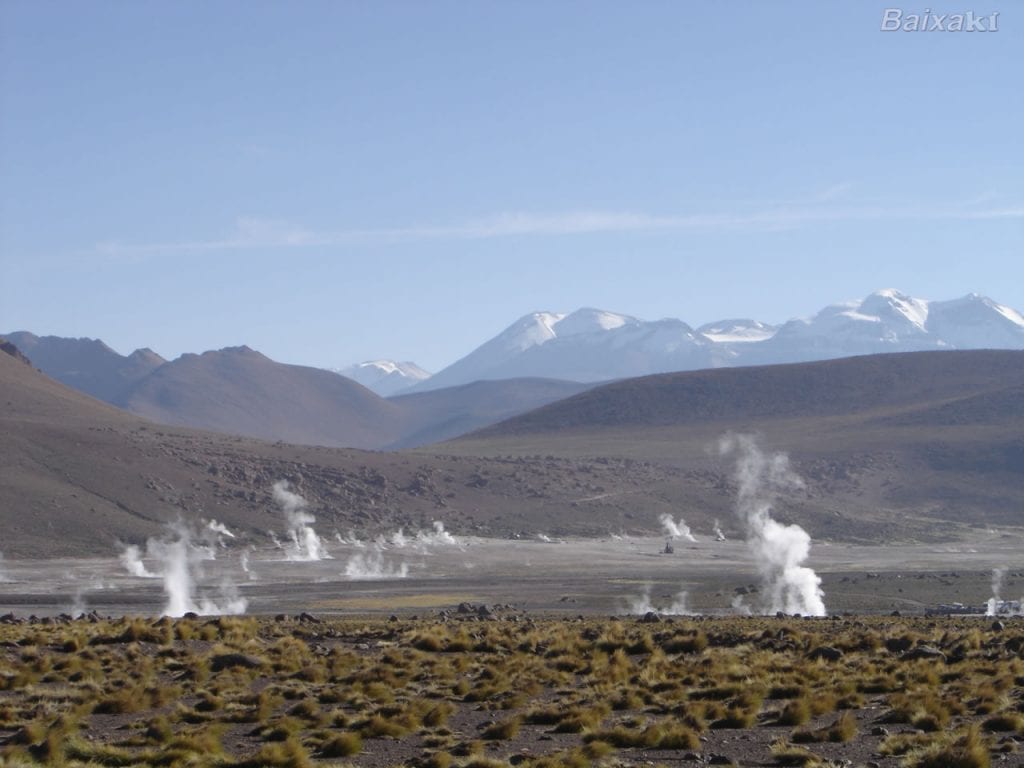
Surely you know what geothermal energy is in general terms but Do you know all the basics about this energy?
In a very general way we say that geothermal energy is heat energy from inside the Earth.
In other words, geothermal energy is the only renewable energy resource that does not derive from the Sun.
In addition, we can say that this energy is not a renewable energy as such, since its renewal is not infinite, However is inexhaustible on a human scale, so it is considered renewable for practical purposes.
Origin of heat inside the Earth
The main cause of heat inside the Earth is the continuous decay of some radioactive elements such as Uranium 238, Thorium 232 and Potassium 40.
Another of the origins of geothermal energy are collisions of tectonic plates.
In certain regions, however, geothermal heat is more concentrated, as occurs in the vicinity of volcanoes, magma currents, geysers and hot springs.
Use of geothermal energy
This energy has been in use for a minimum of 2.000 years.
The Romans used the hot springs to toilets and, more recently, this energy has been used for the heating of buildings and greenhouses and for the generation of electricity.
Currently there are 3 types of deposits from which we can obtain geothermal energy:
- High temperature reservoirs
- Low temperature reservoirs
- Dry hot rock reservoirs
High temperature reservoirs
We say that there is a deposit of high temperature when the reservoir water reaches temperatures above 100ºC due to the presence of an active heat source.
In order for geothermal heat to create usable geothermal energy, geological conditions must make it possible to form a geothermal reservoir, similar to those contained in oil or natural gas, consisting of a permeable rock, sandstones or limestone for example, topped by a waterproof layer, like clay.
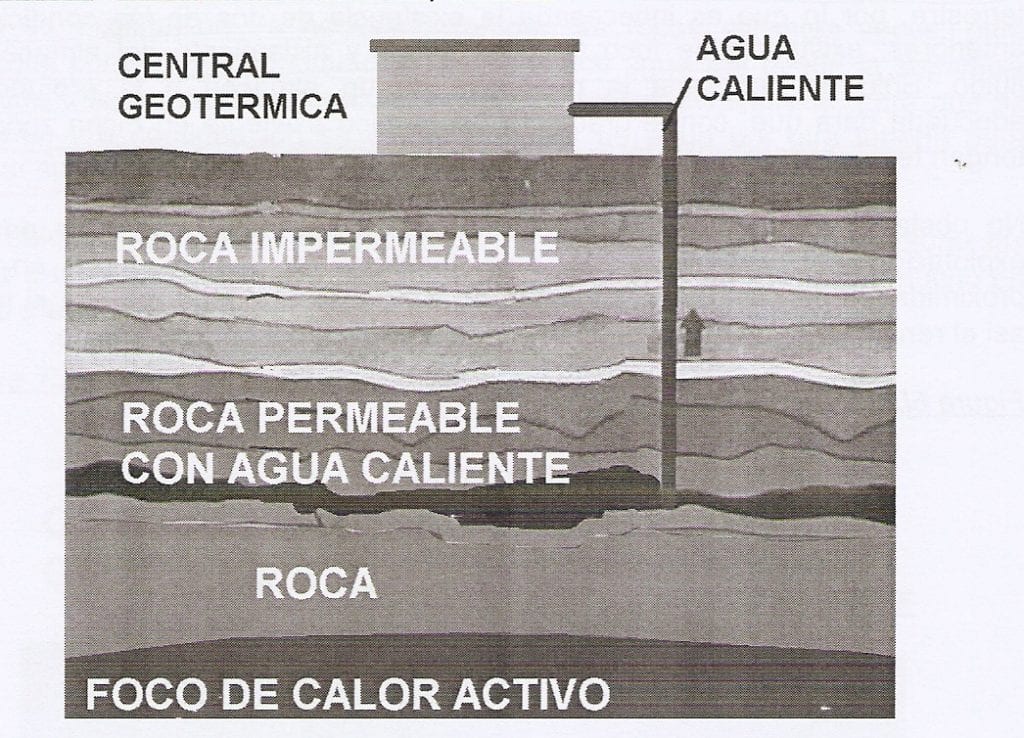
The groundwater heated by the rocks passes in an upward direction to the reservoir, where they remain trapped under the impermeable layer.
When there are cracks in said impermeable layer, the escape of steam or water to the surface is possible, appearing in the form of hot springs or geysers.
These hot springs have been used since ancient times and can easily be used for heating and industrial processes.
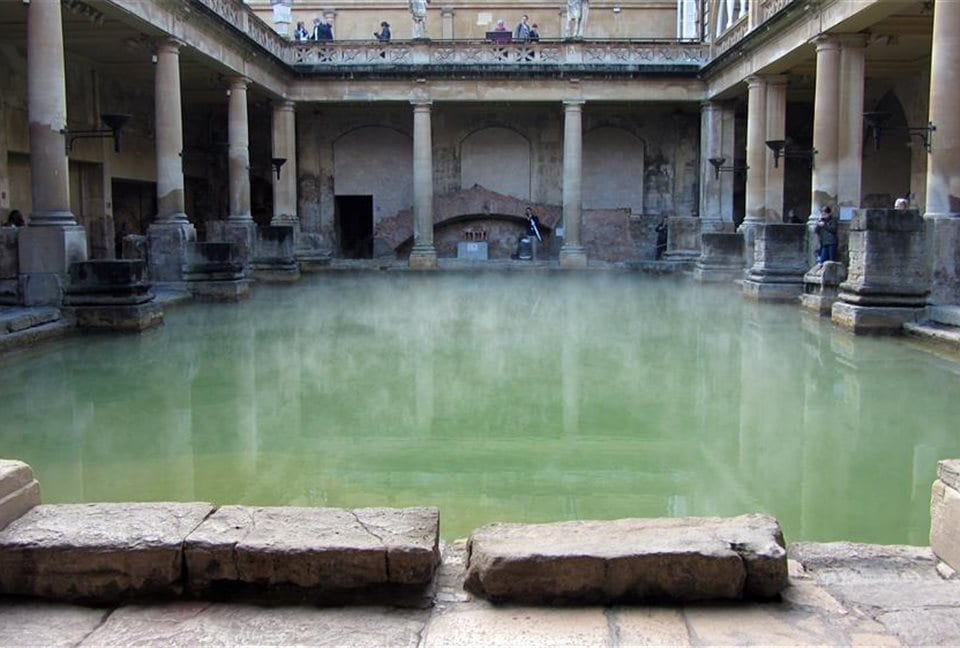
Roman Baths of Bath
Low temperature reservoirs
Low-temperature reservoirs are those in which the water's temperature, which we are going to use, is located between 60 and 100ºC.
In these deposits, the value of the heat flux is the normal of the earth's crust, so the existence of 2 of the previous conditions is unnecessary: existence of an active heat source and insulation of the fluid store.

Only the presence of a warehouse at the appropriate depth so that, with the existing geothermal gradient in said area, there are temperatures that make its exploitation economical.
Dry hot rock reservoirs
The potential of geothermal energy es mucho greater if heat is extracted from dry hot rocks, which do not contain water naturally.
They are at a temperature between 250 and 300ºC already a depth between 2.000 and 3.000 meters.
For its exploitation it is necessary to break dry hot rocks, to make them porous.
Then cold water is introduced from the surface through a pipe, letting it pass through the fractured hot rock, so that it heats up and then, water vapor is extracted through another pipe to use its pressure to drive a turbine and generate electrical energy.
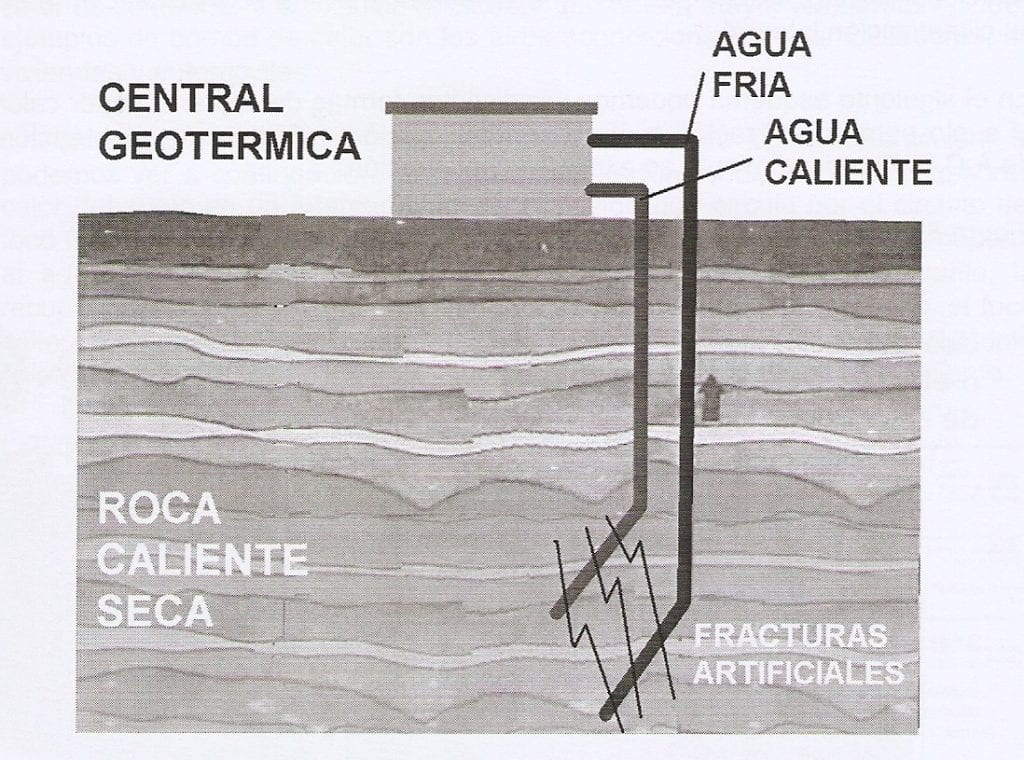
The problem with this type of exploitation is the techniques for fracturing the rocks at such depth and drilling.
Although much progress has been made in these areas using oil drilling techniques.
Very low temperature geothermal energy
We can consider the subsoil to small depths like a heat source at 15ºC, totally renewable and inexhaustible.
By means of a suitable capture system and a heat pump, heat can be transferred from this source at 15ºC to a system that reaches 50ºC, and the latter can be used for heating and obtaining sanitary hot water for use in the home.
In addition, the same heat pump can absorb heat from the environment at 40ºC and deliver it to the subsoil with the same capture systemTherefore, the system that can solve domestic heating can also solve cooling, that is, the house has a single installation for its integral air conditioning.
The main drawback of this type of energy is the need a very large burial surface of the outer circuitHowever, its main advantage is the pPossibility of using it as a heating and cooling system at a very low cost.
In the following diagram you can see different ways of capturing or transferring heat to the floor for later use in heating, cooling and obtaining DHW (sanitary hot water). I will explain the procedure below.
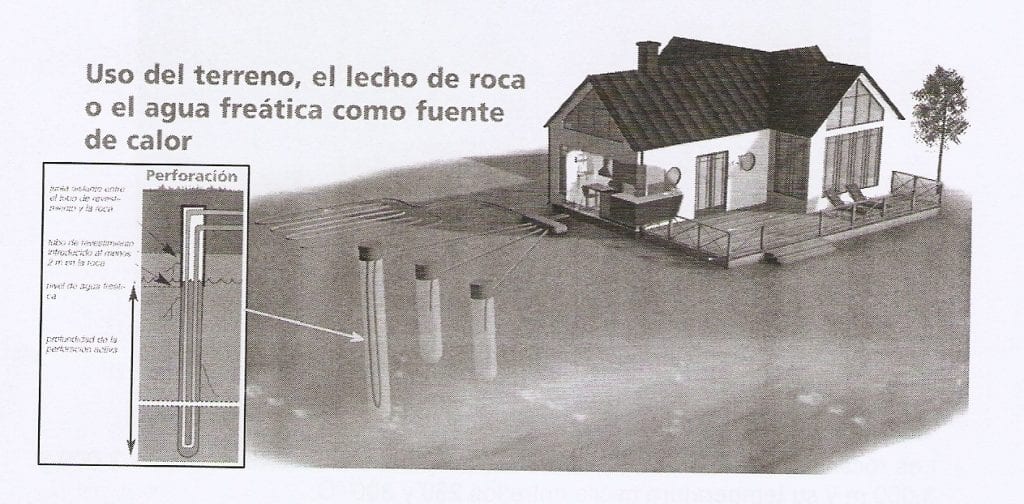
Air conditioning of a house, a block of flats, a hospital, etc. can be reached individually, since it does not require large investments for the system, unlike high and medium temperature geothermal facilities.
This system of harnessing the solar energy absorbed by the Earth's surface is based on 3 main elements:
- Heat pump
- Exchange circuit with Earth
- Heat exchange with surface waters
- Exchange with the ground
- Exchange circuit with the home
Heat pump
The heat pump is a thermodynamic machine which is based on the Carnot Cycle performed by a gas.
This machine absorbs heat from one source to deliver it to another that is at a higher temperature.
The most typical example is refrigeratorsThese have a machine that extracts heat from the inside and expels it to the outside, which is at a higher temperature.
Other examples of heat pumps are air conditioners and air conditioners for homes and automobiles.
In this schematic, you can see that the Cold bulb absorbs heat from the ground in an exchange and the liquid that circulates through the cold bulb circuit absorbs heat until it evaporates.
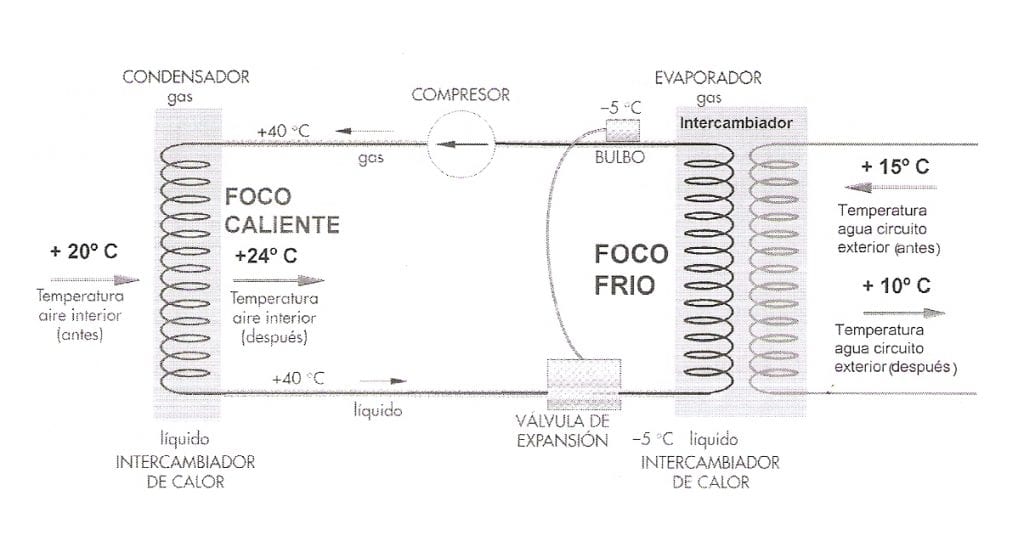
The circuit that carries the water with heat from the ground cools and returns to the ground, soil temperature recovery is very fast.
On the other hand, the hot bulb, inside the house, heats the air giving it heat.
The heat pump is “pumping” heat from the cold bulb to the hot bulb.
Performance (energy supplied / energy absorbed) it depends on the temperature of the source supplying the evaporated heat.
Conventional air conditioning systems absorb heat from the atmosphere, which in winter can reach temperatures below -2 ° C.
At these temperatures the evaporator cannot capture practically no heat and the pump performance is very low.
In summer when it is hotter, the pump has to give up the heat from the atmosphere that may be at 40°C, with what the performance is not as good as you might expect.
However, the geothermal catchment system, by having a source to constant temperature, performance is always optimal regardless of atmospheric temperature conditions. So this system is much more efficient than a conventional heat pump.
Exchange circuits with the Earth
Heat exchange with surface waters
This system is based on put water in thermal contact coming from a surface source with the evaporator / condenser, according to the needs, for the absorption or transfer of heat to said waters.
Advantage: presents is that it has a low cost
Inconvenient: there is not always a source of water available.
Exchange with the ground
This can be direct when the exchange between the ground and the evaporator / condenser of the heat pump is carried out by means of a buried copper pipe.
For a house, between 100 and 150 meters of pipe may be required.
- Advantages: low cost, simplicity and good performance.
- Drawbacks: possibility of gas leaks and freezing of areas of the ground.
Or also can be an auxiliary circuit when it has a set of buried pipes, through which water is circulated, which in turn exchanges heat with the evaporator / condenser.
For a house, between 100 and 200 meters of pipe may be required.
- Advantages: low pressure in the circuit thus avoiding large temperature differences
- Drawbacks: high cost.
Exchange circuits with the home
These circuits can be with a direct exchange or with a distribution of hot and cold water.
Direct exchange It is based on circulating an air stream over the surface of the evaporator / condenser on the side of the house for heat exchange and distributing this hot / cold air throughout the house, through thermally insulated pipes.
With a single distribution system, the distribution of hot and cold in the house is solved.
- Advantages: they usually have a low cost and a lot of simplicity.
- Drawbacks: low performance, moderate comfort and is only applicable to homes that are newly built or have an air convection heating system.
The hot and cold water distribution system it is based on circulating a flow of water over the surface of the evaporator / condenser on the side of the house for heat exchange.
The water is usually cooled down to 10ºC in summer and heated to 45ºC in winter to be used as a means of air conditioning.
Underfloor heating is the best performing and most comfortable method to solve the heating, however, it cannot be used for cooling, so if this method or that of hot water radiators is used, another system will have to be installed to be able to use the cooling.
- Advantages: very high comfort and performance.
- Drawbacks: high cost.
Performance of air conditioning systems
Energy efficiency of an air conditioning system using as a heat source the subsoil at 15ºC is at least of 400% in heating and 500% in cooling.
When it's heating up there is only a contribution of electrical energy of 25% of the total energy required. And when it is used to cool the performance is more than double that of a heat pump exchanging with the air at 40 degrees, so in this case there is also a energy savings of more than 50% compared to a conventional air conditioner.
This means that to pump from the cold pole to the hot pole 4 units of energy (for example 4 calories), only 1 unit of energy is needed.
In refrigeration, for every 5 units pumped, 1 unit is needed to pump them.
This is possible since does not generate all the heatBut most of it is only transferred from one source to another.
The units of energy that we supply to the heat pump are in the form of electrical energy, so basically we are producing CO2 in the electrical energy producing plant, although in much less quantity.
However, we could use non-electric heat pumps, but their source of energy was solar thermal but they are still in the experimental phase.
Si we compare this system with a solar energy capture heating system through panels we can see that presents a great advantage, Ya que does not require large accumulators to compensate for the hours of lack of solar radiation.
The great accumulator is the Earth's own mass that makes us have an energy source at constant temperature, which in the scope of this application behaves as infinite.
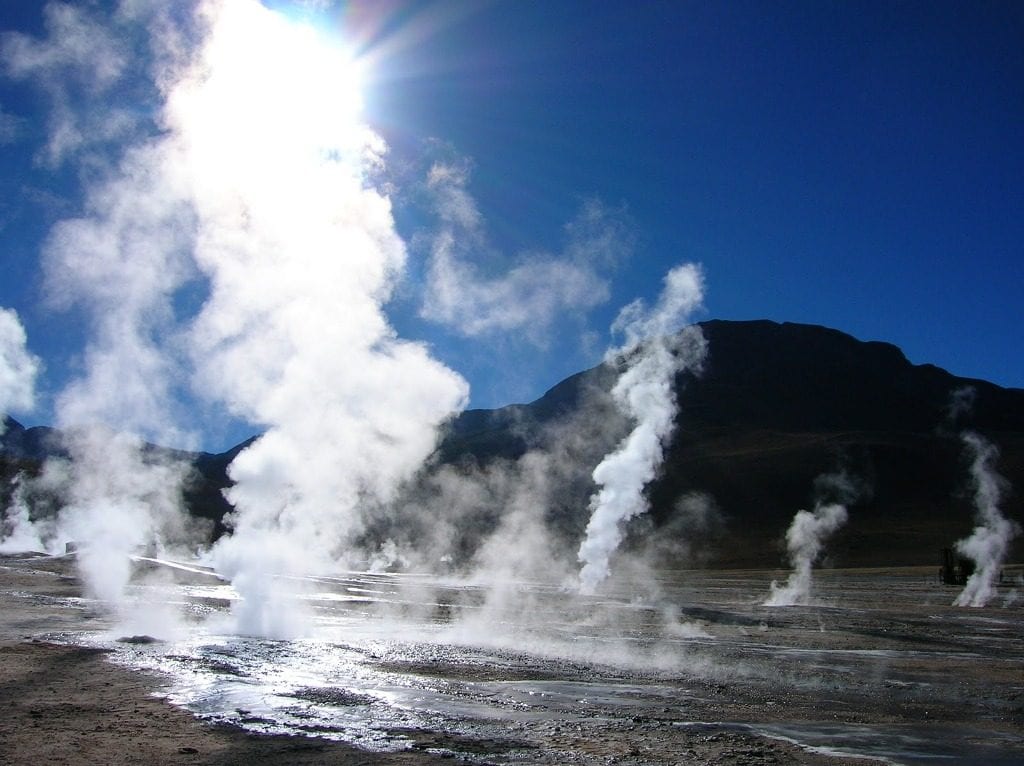
However, the one that does The best option for using this energy source is to combine it with solar thermal energy., not to move the heat pump as mentioned above (which also) but to add heat to the system, given that in heating and domestic hot water production applications, water can be brought to 15ºC using geothermal energy for later, raise the water temperature with solar energy.
In this case the efficiency of the heat pump increases exponentially.
Geothermal energy distribution
Geothermal energy is widespread throughout the planet, especially in the form of dry hot rocks, but there are areas in which it extends perhaps over 10% of the planet's surface and they have special conditions to develop this type of energy.
I mean the Zones in which more manifest the effects of earthquakes and volcanoes and that, in general, coincide with tectonic faults important.
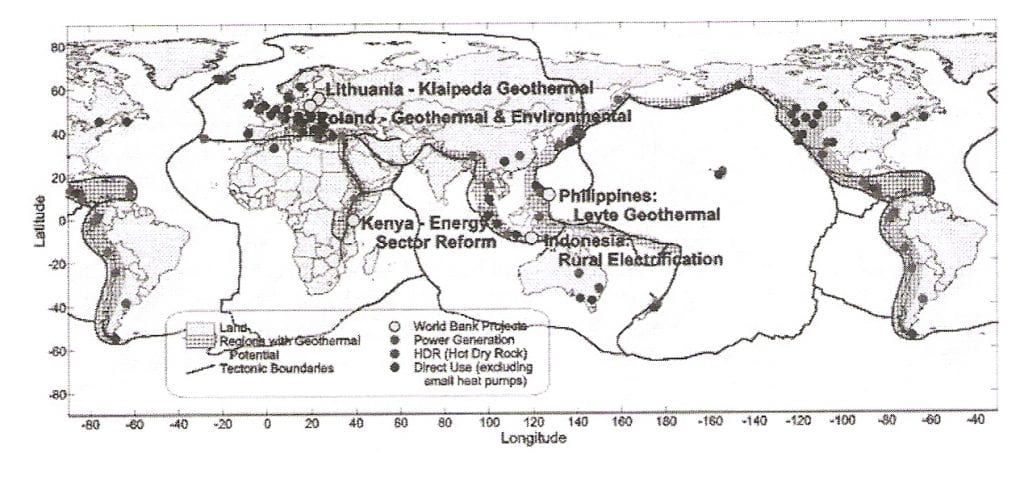
Among them are:
- The Pacific coast of the American Continent, from Alaska to Chile.
- The western Pacific, from New Zealand, through the Philippines and Indonesia, to southern China and Japan.
- The valley of dislocation of Kenya, Uganda, Zaire and Ethiopia.
- The surroundings of the Mediterranean.
Advantages and disadvantages of geothermal energy
This energy, like everything that exists, has its good parts as well as its bad parts.
How to Live Aligned with and advantages we can say that:
- It is distributed all over the planet.
- The most economical geothermal sources are in the volcanic areas located for the most part in developing countries, which can be very useful to improve your situation.
- It is a inexhaustible source of energy on a human scale.
- Is the energy cheaper that is known.
Their disadvantages on the contrary they are:
- The use of geothermal energy presents some environmental problems, in particular, the release of sulphurous gases into the atmosphere, along with hot water discharges to rivers, which often contain a high level of solids.
Although in general, wastewater can be reinjected into the earth, after having extracted, in some cases, commercially usable potassium salts.
- En general, transmission of geothermal heat over long distances is not feasible. Hot water or steam should be used in the vicinity of its source, before it cools down.
- Most of the geothermal waters are found temperatures below 150ºC so in general, it is not hot enough for electricity generation.
These waters can only be used for bathing, heating buildings and greenhouses and outdoor crops, or as preheated water for boilers.
- The dry hot rock reservoirs are short livedAs cracked surfaces cool down quickly, their energy efficiency drops rapidly.
- The installation costs are very high.
The future of geothermal energy
So far, only perforations and extract heat to depths of about 3 km, although it is expected to be able to reach greater depths, with which geothermal energy could be used more widely.
The total energy availablein the way of hot water, steam or hot rocks, up to a depth of 10 km, approaches 3.1017 pulse. 30 million times the current world energy consumption. Which indicates that geothermal energy can be an interesting alternative in the short term.
The techniques perfected for the development of geothermal resources are very similar to those used in the oil sector. However, since the energy content of water at 300ºC is a thousand times lower than that of oil, the capital can be economically invested in exploration and drilling is much less.
However, oil shortages may fuel the increasing use of geothermal energy.
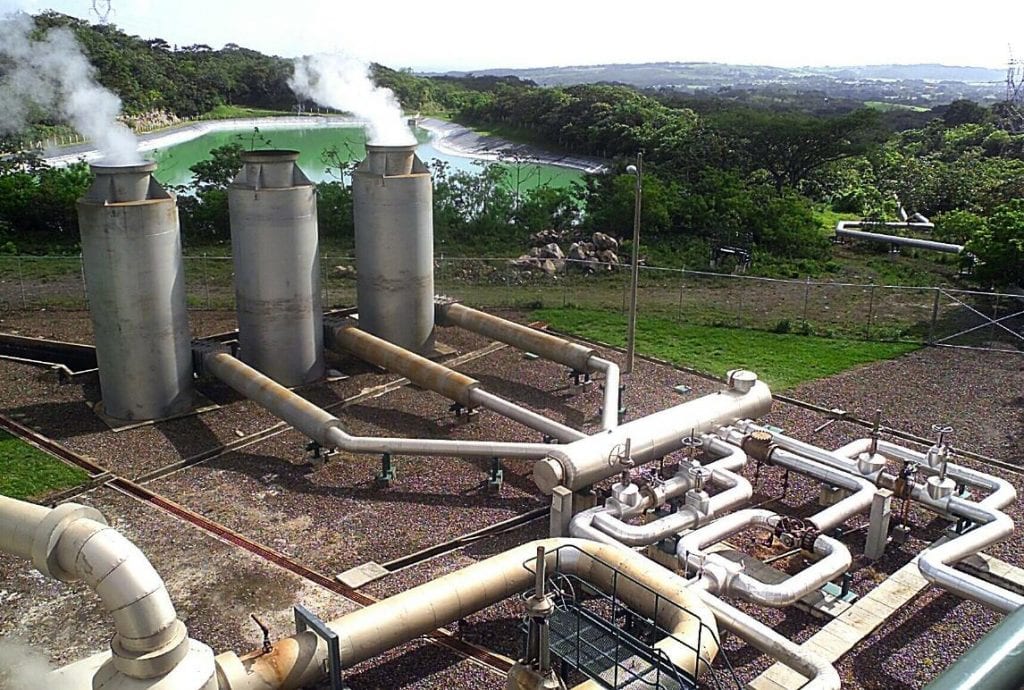
On the other hand, it has always been possible to use of geothermal sources for the generation of electricity in medium-sized turbo-generators (10-100MW) located near the well sites, but the minimum usable geothermal temperature for electricity generation was 150ºC.
Lately bladeless turbines have been developed for geothermal water and steam up to 100ºC only, which allows to expand the field of use of this energy.
In addition, can be used in industrial processes such as the processing of metals, the heating of industrial processes of all kinds, the heating of greenhouses, etc.
But probably the greatest future of geothermal energy lies in the utilization of very low temperature geothermal energy, due to its versatility, simplicity, low economic and environmental cost and the possibility of use it as a heating and cooling system.